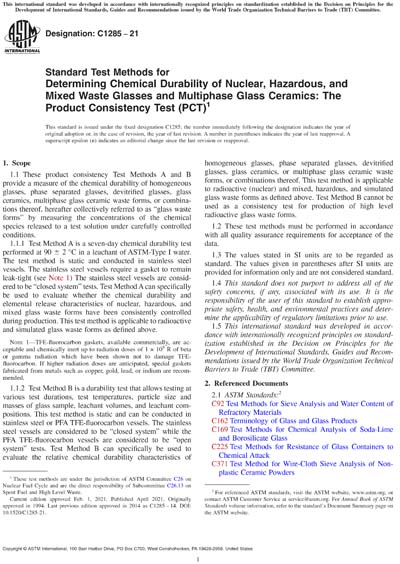Most recent
ASTM C1285-21
Standard Test Methods for Determining Chemical Durability of Nuclear, Hazardous, and Mixed Waste Glasses and Multiphase Glass Ceramics: The Product Consistency Test (PCT)
1.1 These product consistency Test Methods A and B provide a measure of the chemical durability of homogeneous glasses, phase separated glasses, devitrified glasses, glass ceramics, multiphase glass ceramic waste forms, or combinations thereof, hereafter collectively referred to as “glass waste forms†by measuring the concentrations of the chemical species released to a test solution under carefully controlled conditions.
1.1.1 Test Method A is a seven-day chemical durability test performed at 90 ± 2 °C in a leachant of ASTM-Type I water. The test method is static and conducted in stainless steel vessels. The stainless steel vessels require a gasket to remain leak-tight (see Note 1) The stainless steel vessels are considered to be “closed system†tests. Test Method A can specifically be used to evaluate whether the chemical durability and elemental release characteristics of nuclear, hazardous, and mixed glass waste forms have been consistently controlled during production. This test method is applicable to radioactive and simulated glass waste forms as defined above.
Note 1: TFE-fluorocarbon gaskets, available commercially, are acceptable and chemically inert up to radiation doses of 1 × 105 R of beta or gamma radiation which have been shown not to damage TFE-fluorocarbon. If higher radiation doses are anticipated, special gaskets fabricated from metals such as copper, gold, lead, or indium are recommended.
1.1.2 Test Method B is a durability test that allows testing at various test durations, test temperatures, particle size and masses of glass sample, leachant volumes, and leachant compositions. This test method is static and can be conducted in stainless steel or PFA TFE-fluorocarbon vessels. The stainless steel vessels are considered to be “closed system†while the PFA TFE-fluorocarbon vessels are considered to be “open system†tests. Test Method B can specifically be used to evaluate the relative chemical durability characteristics of homogeneous glasses, phase separated glasses, devitrified glasses, glass ceramics, or multiphase glass ceramic waste forms, or combinations thereof. This test method is applicable to radioactive (nuclear) and mixed, hazardous, and simulated glass waste forms as defined above. Test Method B cannot be used as a consistency test for production of high level radioactive glass waste forms.
1.2 These test methods must be performed in accordance with all quality assurance requirements for acceptance of the data.
1.3 The values stated in SI units are to be regarded as standard. The values given in parentheses after SI units are provided for information only and are not considered standard.
1.4 This standard does not purport to address all of the safety concerns, if any, associated with its use. It is the responsibility of the user of this standard to establish appropriate safety, health, and environmental practices and determine the applicability of regulatory limitations prior to use.
1.5 This international standard was developed in accordance with internationally recognized principles on standardization established in the Decision on Principles for the Development of International Standards, Guides and Recommendations issued by the World Trade Organization Technical Barriers to Trade (TBT) Committee.
Content Provider
ASTM International [astm]






